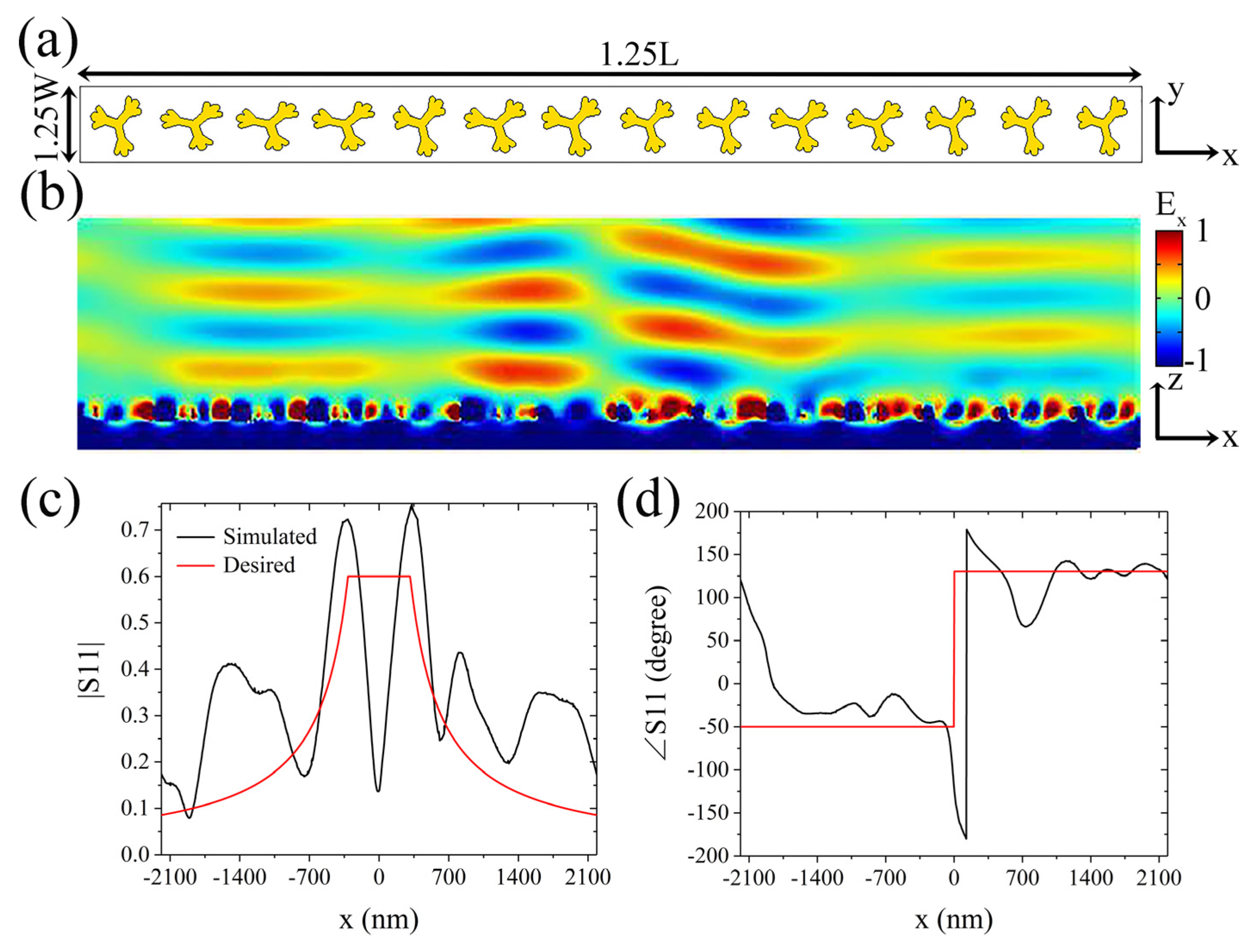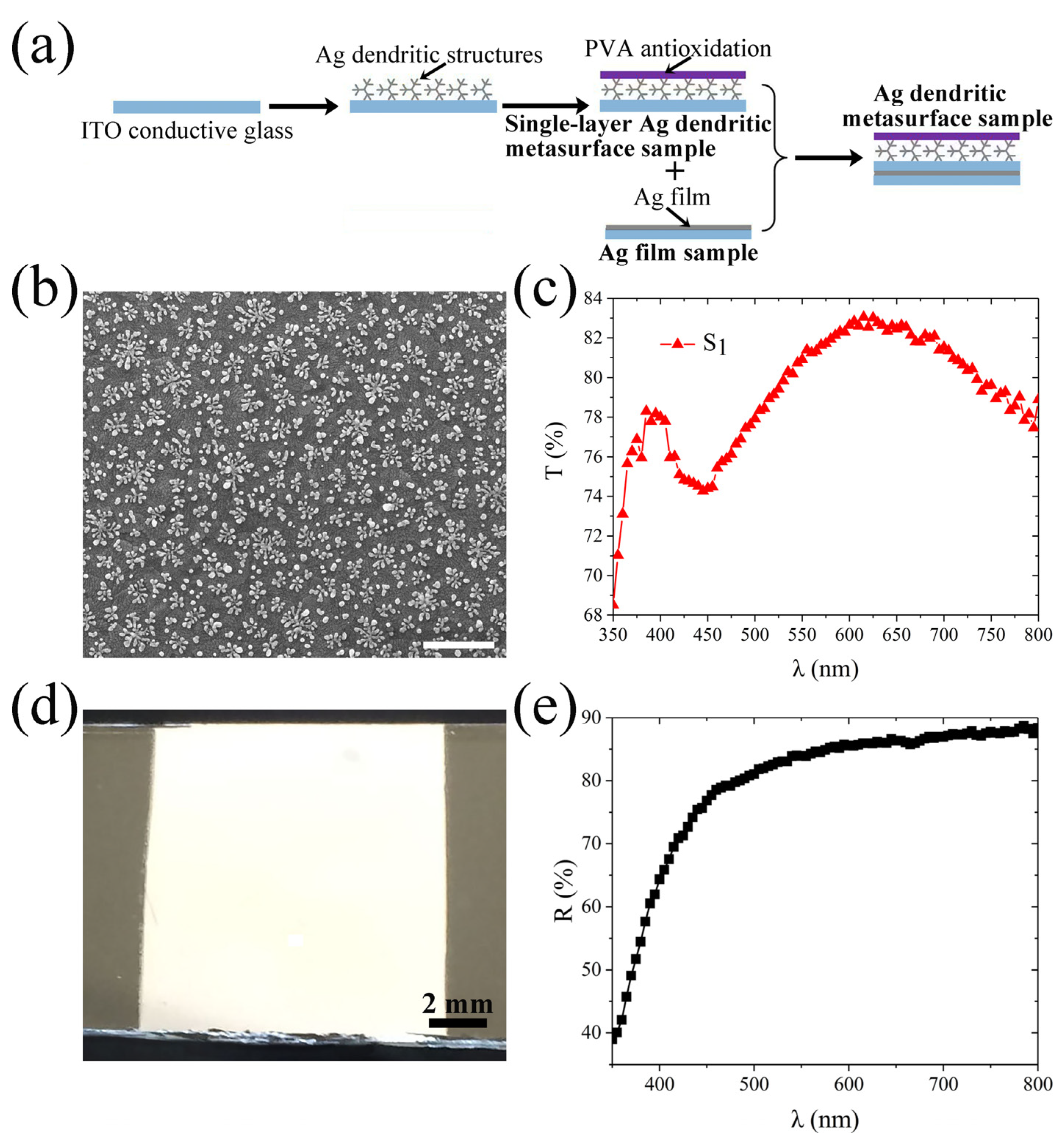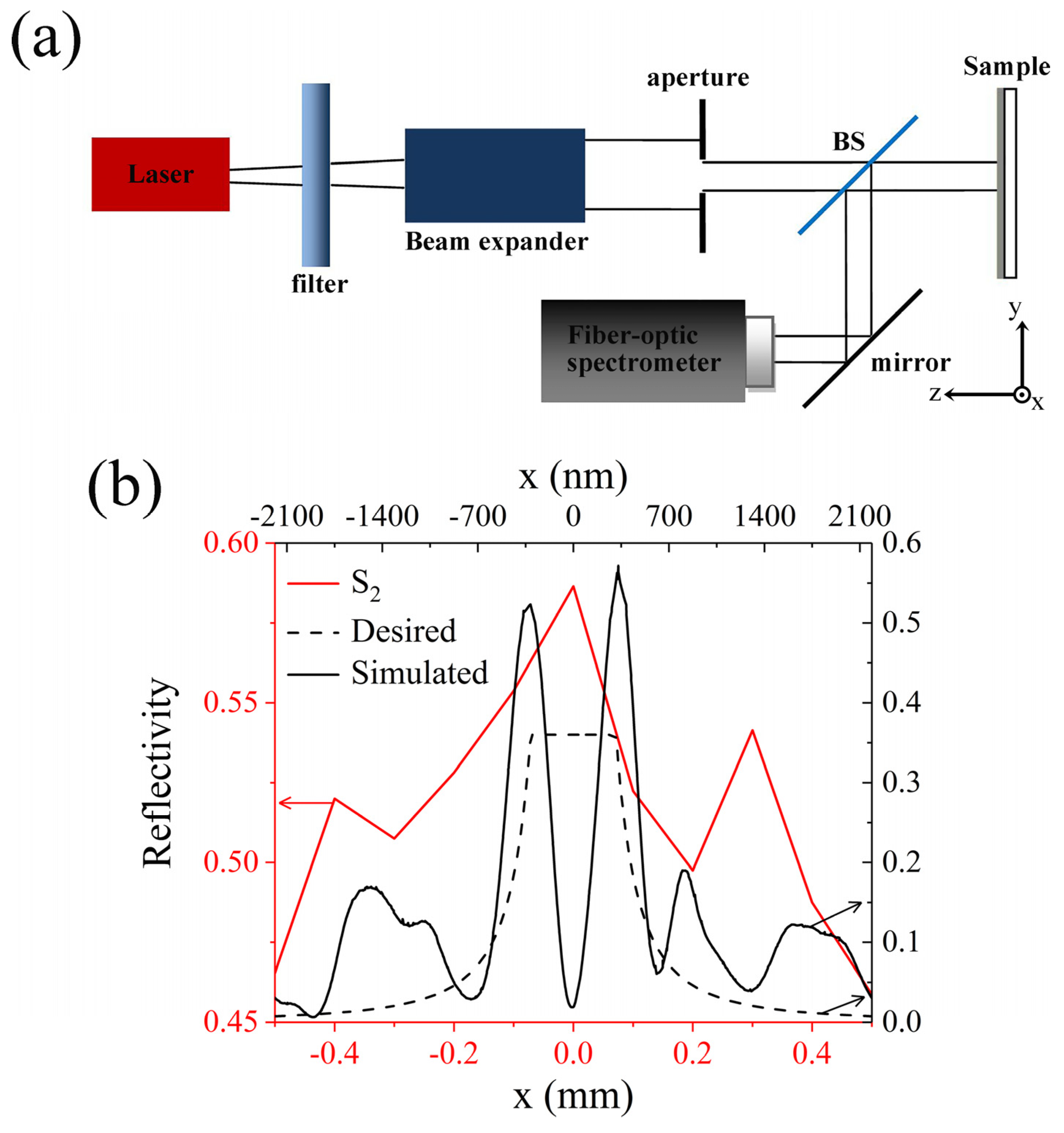Quasi-Periodic Dendritic Metasurface for Integral Operation in Visible Light
Abstract
1. Introduction
2. Design of Integral Metasurfaces
2.1. Design Principle
2.2. Design of Ag Dendritic Metasurface
3. Simulation and Experiment for the Integral Property of the Dendritic Metasurface
3.1. Simulation
3.2. Preparation of Ag Dendritic Metasurface Sample
3.3. Reflectivity Measurement of Dendritic Metasurface
4. Conclusions
Author Contributions
Funding
Conflicts of Interest
References
- Price, D.D.S. A history of calculating machines. Ieee Micro. 1984, 4, 22–52. [Google Scholar] [CrossRef]
- Clymer, A.B. The mechanical analog computers of Hannibal Ford and William Newell. Ieee Ann. Hist. Comput. 1993, 15, 19–34. [Google Scholar] [CrossRef]
- Solli, D.R.; Jalali, B. Analog optical computing. Nat. Photonics 2015, 9, 704–706. [Google Scholar] [CrossRef]
- Nakamura, J. Image Sensors and Signal Processing for Digital Still Cameras; CRC press: Boca Raton, FL, USA, 2016. [Google Scholar]
- Miller, D.A.B. Are optical transistors the logical next step? Nat. Photonics 2010, 4, 3–5. [Google Scholar] [CrossRef]
- Yu, N.; Genevet, P.; Aieta, F.; Kats, M.A.; Blanchard, R.; Aoust, G.; Tetienne, J.P.; Gaburro, Z.; Capasso, F. Flat optics: Controlling wavefronts with optical antenna metasurfaces. Ieee J. Sel. Top. Quantum Electron. 2013, 19, 4700423. [Google Scholar]
- Silva, A.; Monticone, F.; Castaldi, G.; Galdi, V.; Alù, A.; Engheta, N. Performing mathematical operations with metamaterials. Science 2014, 343, 160–163. [Google Scholar] [CrossRef]
- Yu, N.; Genevet, P.; Kats, M.A.; Aieta, F.; Tetienne, J.P.; Capasso, F.; Gaburro, Z. Light propagation with phase discontinuities: Generalized laws of reflection and refraction. Science 2011, 334, 333–337. [Google Scholar] [CrossRef]
- Zhao, Y.; Alù, A. Manipulating light polarization with ultrathin plasmonic metasurfaces. Phys. Rev. B 2011, 84, 205428. [Google Scholar] [CrossRef]
- Yu, N.; Capasso, F. Flat optics with designer metasurfaces. Nat. Mater. 2014, 13, 139–150. [Google Scholar] [CrossRef]
- Minatti, G.; Maci, S.; Vita, P.D.; Freni, A.; Sabbadini, M. A circularly-polarized isoflux antenna based on anisotropic metasurface. Ieee Trans. Antenn. Propag. 2012, 60, 4998–5009. [Google Scholar] [CrossRef]
- Hasman, E. Spin-optical metasurface route to spin-controlled photonics. Science 2013, 340, 724. [Google Scholar]
- Pors, A.; Nielsen, M.G.; Eriksen, R.L.; Bozhevolnyi, S.I. Broadband focusing flat mirrors based on plasmonic gradient metasurfaces. Nano Lett. 2013, 13, 829–834. [Google Scholar] [CrossRef] [PubMed]
- Lin, D.; Fan, P.; Hasman, E.; Brongersma, M.L. Dielectric gradient metasurface optical elements. Science 2014, 345, 298–302. [Google Scholar] [CrossRef] [PubMed]
- Cheng, Y.; Zhou, C.; Yuan, B.G.; Wu, D.J.; Wei, Q.; Liu, X.J. Ultra-sparse metasurface for high reflection of low-frequency sound based on artificial Mie resonances. Nat. Mater. 2015, 14, 1013–1019. [Google Scholar] [CrossRef] [PubMed]
- Pors, A.; Nielsen, M.G.; Bozhevolnyi, S.I. Analog computing using reflective plasmonic metasurfaces. Nano Lett. 2015, 15, 791–797. [Google Scholar] [CrossRef]
- Zheng, G.; Mühlenbernd, H.; Kenney, M.; Li, G.; Zentgraf, T.; Zhang, S. Metasurface holograms reaching 80% efficiency. Nat. Nanotechnol. 2015, 10, 308–312. [Google Scholar] [CrossRef]
- Qin, F.; Ding, L.; Zhang, L.; Monticone, F.; Chum, C.C.; Deng, J.; Mei, S.; Li, Y.; Teng, J.; Hong, M.; et al. Hybrid bilayer plasmonic metasurface efficiently manipulates visible light. Sci. Adv. 2016, 2, e1501168. [Google Scholar] [CrossRef]
- Arbabi, A.; Arbabi, E.; Horie, Y.; Kamali, S.M.; Faraon, A. Planar metasurface retroreflector. Nat. Photonics 2017, 11, 415–420. [Google Scholar] [CrossRef]
- Li, P.; Dolado, I.; Alfaro-Mozaz, F.J.; Casanova, F.; Hueso, L.E.; Liu, S.; Edgar, J.H.; Nikitin, A.Y.; Vélez, S.; Hillenbrand, R. Infrared hyperbolic metasurface based on nanostructured Van der Waals materials. Science 2018, 359, 892–896. [Google Scholar] [CrossRef]
- Li, L.; Ruan, H.; Liu, C.; Li, Y.; Shuang, Y.; Alù, A.; Qiu, C.-W.; Cui, T.J. Machine-learning reprogrammable metasurface imager. Nat. Commun. 2019, 10, 1082. [Google Scholar] [CrossRef]
- Zhou, J.; Qian, H.; Chen, C.F.; Zhao, J.; Li, G.; Wu, Q.; Luo, H.; Wen, S.; Liu, Z. Optical edge detection based on high-efficiency dielectric metasurface. Proc. Natl. Acad. Sci. USA 2019, 116, 11137–11140. [Google Scholar] [CrossRef] [PubMed]
- Momeni, A.; Rajabalipanah, H.; Abdolali, A.; Achouri, K. Generalized optical signal processing based on multioperator metasurfaces synthesized by susceptibility tensors. Phys. Rev. Appl. 2019, 11, 064042. [Google Scholar] [CrossRef]
- Abdolali, A.; Momeni, A.; Rajabalipanah, H.; Achouri, K. Parallel integro-differential equation solving via multi-channel reciprocal bianisotropic metasurface augmented by normal susceptibilities. New J. Phys. 2019, 21, 113048. [Google Scholar] [CrossRef]
- Kwon, H.; Sounas, D.; Cordaro, A.; Polman, A.; Alù, A. Nonlocal metasurfaces for optical signal processing. Phys. Rev. Lett. 2018, 121, 173004. [Google Scholar] [CrossRef] [PubMed]
- Babashah, H.; Kavehvash, Z.; Koohi, S.; Khavasi, A. Integration in analog optical computing using metasurfaces revisited: Toward ideal optical integration. J. Opt. Soc. Am. B 2017, 34, 1270–1279. [Google Scholar] [CrossRef]
- Abdollahramezani, S.; Chizari, A.; Dorche, A.E.; Jamali, M.V.; Salehi, J.A. Dielectric metasurfaces solve differential and integro-differential equations. Opt. Lett. 2017, 42, 1197–1200. [Google Scholar] [CrossRef] [PubMed]
- Chizari, A.; Abdollahramezani, S.; Jamali, M.V.; Salehi, J.A. Analog optical computing based on a dielectric meta-reflect array. Opt. Lett. 2016, 41, 3451–3454. [Google Scholar] [CrossRef]
- AbdollahRamezani, S.; Arik, K.; Khavasi, A.; Kavehvash, Z. Analog computing using graphene-based metalines. Opt. Lett. 2015, 40, 5239–5242. [Google Scholar] [CrossRef]
- Chen, H.; An, D.; Li, Z.; Zhao, X. Performing differential operation with a silver dendritic metasurface at visible wavelengths. Opt. Express 2017, 25, 26417–26426. [Google Scholar] [CrossRef]
- Zhou, X.; Fu, Q.H.; Zhao, J.; Yang, Y.; Zhao, X.P. Negative permeability and subwavelength focusing of quasi-periodic dendritic cell metamaterials. Opt. Express 2006, 14, 7188–7197. [Google Scholar] [CrossRef]
- Chen, H.; Zhao, J.; Fang, Z.; An, D.; Zhao, X. Visible light metasurfaces assembled by quasiperiodic dendritic cluster sets. Adv. Mater. Interfaces 2019, 6, 1801834. [Google Scholar] [CrossRef]
- Liu, H.; Zhao, X.; Yang, Y.; Li, Q.; Lv, J. Fabrication of infrared left-handed metamaterials via double template-assisted electrochemical deposition. Adv. Mater. 2008, 20, 2050–2054. [Google Scholar] [CrossRef]
- Liu, B.; Zhao, X.; Zhu, W.; Luo, W.; Cheng, X. Multiple pass-band optical left-handed metamaterials based on random dendritic cells. Adv. Funct. Mater. 2008, 18, 3523–3528. [Google Scholar] [CrossRef]
- Zhao, X. Bottom-up fabrication methods of optical metamaterials. J. Mater. Chem. 2012, 22, 9439–9449. [Google Scholar] [CrossRef]
- Pors, A.; Bozhevolnyi, S.I. Plasmonic metasurfaces for efficient phase control in reflection. Opt Express 2013, 21, 27438–27451. [Google Scholar] [CrossRef]
- Dickey, F.M. Laser Beam Shaping: Theory and Techniques; CRC press: New York, NY, USA, 2000. [Google Scholar]
- Farmahini-Farahani, M.; Cheng, J.; Mosallaei, H. Metasurfaces nanoantennas for light processing. J. Opt. Soc. Am. B 2013, 30, 2365–2370. [Google Scholar] [CrossRef]
- Lin, L.; Goh, X.M.; Mcguinness, L.P.; Roberts, A. Plasmonic lenses formed by two-dimensional nanometric cross-shaped aperture arrays for Fresnel-region focusing. Nano Lett. 2010, 10, 1936–1940. [Google Scholar] [CrossRef]
- Gottheim, S.; Zhang, H.; Govorov, A.O.; Halas, N.J. Fractal nanoparticle plasmonics: The Cayley tree. Acs Nano 2015, 9, 3284–3292. [Google Scholar] [CrossRef]
- Ahmadivand, A.; Gerislioglu, B.; Sinha, R.; Vabbina, P.K.; Karabiyik, M.; Pala, N. Excitation of terahertz charge transfer plasmons in metallic fractal structures. J. Infr. Millim. Terahertz Waves 2017, 38, 992–1003. [Google Scholar] [CrossRef]
- Cheng, S.; An, D.; Chen, H.; Zhao, X. Plate-focusing based on a meta-molecule of dendritic structure in the visible frequency. Molecules 2018, 23, 1323. [Google Scholar] [CrossRef]
- Johnson, P.B.; Christy, R.W. Optical constants of the noble metals. Phys. Rev. B 1972, 6, 4370–4379. [Google Scholar] [CrossRef]
- Fang, Z.H.; Chen, H.; Yang, F.S.; Luo, C.R.; Zhao, X.P. Slowing down light using a dendritic cell cluster metasurface waveguide. Sci. Rep. 2016, 6, 37856. [Google Scholar] [CrossRef] [PubMed]
Sample Availability: Samples are available from the corresponding author. |





© 2020 by the authors. Licensee MDPI, Basel, Switzerland. This article is an open access article distributed under the terms and conditions of the Creative Commons Attribution (CC BY) license (http://creativecommons.org/licenses/by/4.0/).
Share and Cite
Chen, H.; An, D.; Zhao, X. Quasi-Periodic Dendritic Metasurface for Integral Operation in Visible Light. Molecules 2020, 25, 1664. https://doi.org/10.3390/molecules25071664
Chen H, An D, Zhao X. Quasi-Periodic Dendritic Metasurface for Integral Operation in Visible Light. Molecules. 2020; 25(7):1664. https://doi.org/10.3390/molecules25071664
Chicago/Turabian StyleChen, Huan, Di An, and Xiaopeng Zhao. 2020. "Quasi-Periodic Dendritic Metasurface for Integral Operation in Visible Light" Molecules 25, no. 7: 1664. https://doi.org/10.3390/molecules25071664
APA StyleChen, H., An, D., & Zhao, X. (2020). Quasi-Periodic Dendritic Metasurface for Integral Operation in Visible Light. Molecules, 25(7), 1664. https://doi.org/10.3390/molecules25071664




